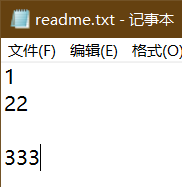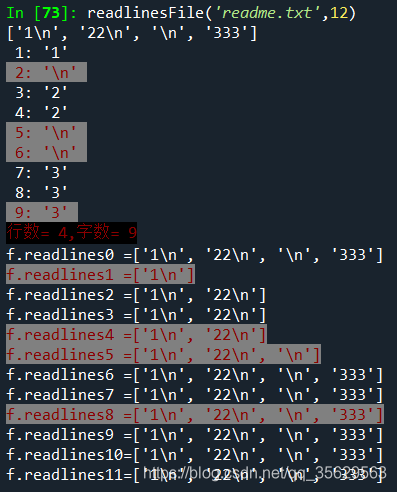本篇内容主要讲解“python中readlines函数的参数hint的介绍以及用法”,感兴趣的朋友不妨来看看。本文介绍的方法操作简单快捷,实用性强。下面就让小编来带大家学习“python中readlines函数的参数hint的介绍以及用法”吧!
>>> fr=open('readme.txt')
>>> help(fr.readlines)
Help on built-in function readlines:
readlines(hint=-1, /) method of _io.TextIOWrapper instance
Return a list of lines from the stream.
hint can be specified to control the number of lines read: no more
lines will be read if the total size (in bytes/characters) of all
lines so far exceeds hint._io.TextIOWrapper 实例的 readlines(hint=-1, /) 方法
从流中返回行列表。
可以指定 hint 来控制读取的行数:如果到目前为止所有行的总大小(以字节/字符为单位)超过hint,则不会读取更多行。

>>> f=open('readme.txt')
>>> f.readlines()
['1\n', '22\n', '\n', '333']为了进一步搞清楚hint,我写了一个函数来演示
def readlinesFile(filename,nbyte):
'''
探索f.readlines(i)中i的作用,典型的调用形式:
readlinesFile('readme.txt',12)
'''
for i in range(nbyte):
f=open(filename)
ss=f.readlines(i)
if i==0:#如果hint=0,先把每一个元素输出
textline=len(ss)#文件的总行数
ntotalbyte=0#文件的总字数
nwritebyte=0#已经写了的字节数
for j in range(textline):
#nwritebyte=ntotalbyte#已经写了的字节数
ntotalbyte=ntotalbyte+len(ss[j])
rowbyte=0#已经写了的新行的字节数,用来记一行已经输出的字节个数
while nwritebyte<ntotalbyte:#当已写字节<总字节数
print(f'{nwritebyte+1}:',repr(ss[j][rowbyte])) #repr是为了输出换行符
nwritebyte=nwritebyte+1
rowbyte=rowbyte+1
print(f'行数={textline},字数={ntotalbyte}')
print(f'f.readlines{i}={ss}')
f.close()输出
>>> readlinesFile('readme.txt',12)
1: '1'
2: '\n'
3: '2'
4: '2'
5: '\n'
6: '\n'
7: '3'
8: '3'
9: '3'
行数=4,字数=9
f.readlines0=['1\n', '22\n', '\n', '333']
f.readlines1=['1\n']
f.readlines2=['1\n', '22\n']
f.readlines3=['1\n', '22\n']
f.readlines4=['1\n', '22\n']
f.readlines5=['1\n', '22\n', '\n']
f.readlines6=['1\n', '22\n', '\n', '333']
f.readlines7=['1\n', '22\n', '\n', '333']
f.readlines8=['1\n', '22\n', '\n', '333']
f.readlines9=['1\n', '22\n', '\n', '333']
f.readlines10=['1\n', '22\n', '\n', '333']
f.readlines11=['1\n', '22\n', '\n', '333']
1.hint 是要输出显示的字节数
2.hint 默认等于-1,就是以列表的形式读出所有内容
3.hint = 0时,效果等同于-1
4.hint 所指的字节数正好是换行符的话,则实际输出是 hint+1
更花哨的readlinesFile
def readlinesFile(filename,nbyte):
'''
探索f.readlines(i)中i是指什么,典型的调用形式:
readlinesFile('readme.txt',12)
'''
specialByte=[]#存储特殊的字节数用
for i in range(nbyte):
with open(filename) as f:#使用with语句就可以不使用f.close()了
ss=f.readlines(i)
if(i==0):#如果hint=0,先把每一个元素输出
print(ss)
textline=len(ss)#文件的总行数
ntotalbyte=0#文件的总字数
nwritebyte=0#已经写了的字节数
for j in range(textline):
#nwritebyte=ntotalbyte#已经写了的字节数
ntotalbyte=ntotalbyte+len(ss[j])
rowbyte=0#已经写了的新行的字节数,用来记一行已经输出的字节个数
while nwritebyte<ntotalbyte:#当已写字节<总字节数
if(nwritebyte is ntotalbyte-1):
specialByte.append(nwritebyte)
print(f'\033[0;31;47m{nwritebyte+1:2d}:',repr(ss[j][rowbyte]),'\033[0m')#\033[0m是字体和背景颜色设置,注意可能需要其他库的支持
else:
print(f'{nwritebyte+1:2d}:',repr(ss[j][rowbyte]))
nwritebyte=nwritebyte+1
rowbyte=rowbyte+1
print(f'\033[0;31;40m行数={textline:2d},字数={ntotalbyte:2d}\033[0m')
if i in specialByte:
print(f'\033[0;31;47mf.readlines{i:<2d}={ss}\033[0m') #<是左对齐
else:
print(f'f.readlines{i:<2d}={ss}') #<是左对齐效果

到此,相信大家对“python中readlines函数的参数hint的介绍以及用法”有了更深的了解,不妨来实际操作一番吧!这里是亿速云网站,更多相关内容可以进入相关频道进行查询,关注我们,继续学习!
免责声明:本站发布的内容(图片、视频和文字)以原创、转载和分享为主,文章观点不代表本网站立场,如果涉及侵权请联系站长邮箱:is@yisu.com进行举报,并提供相关证据,一经查实,将立刻删除涉嫌侵权内容。